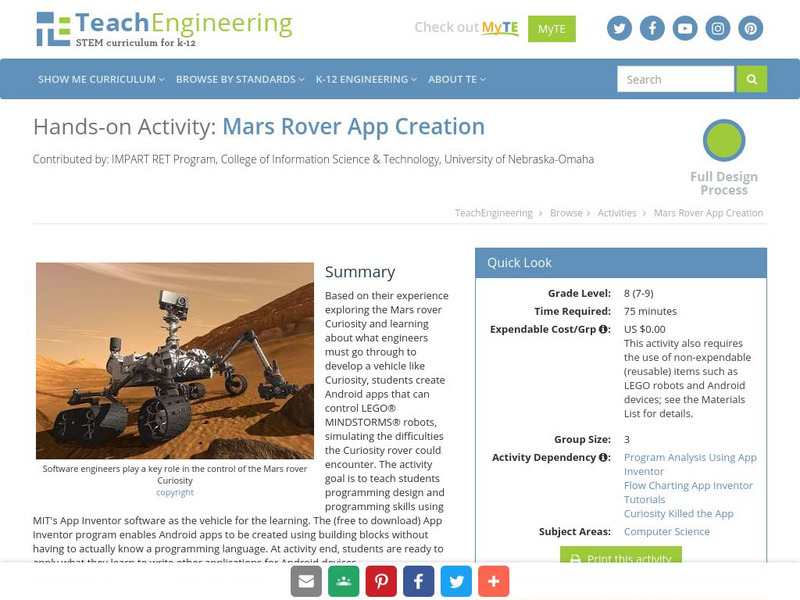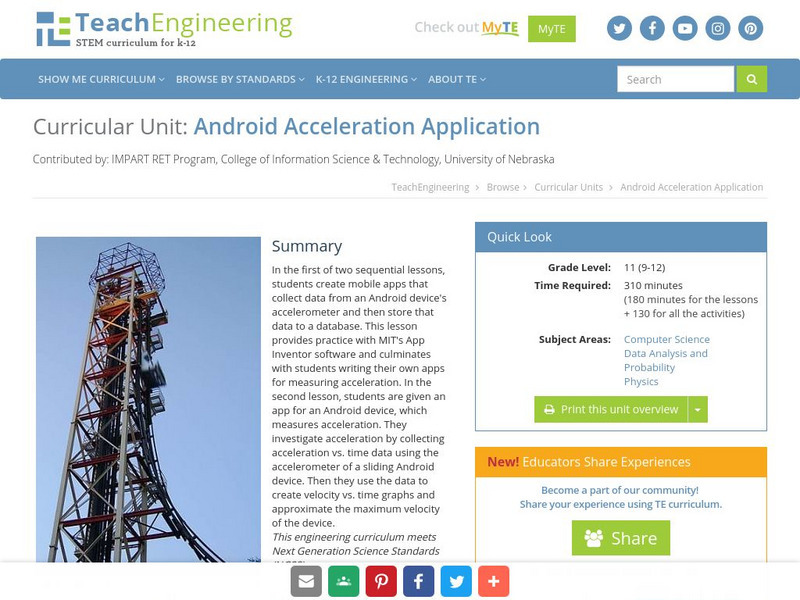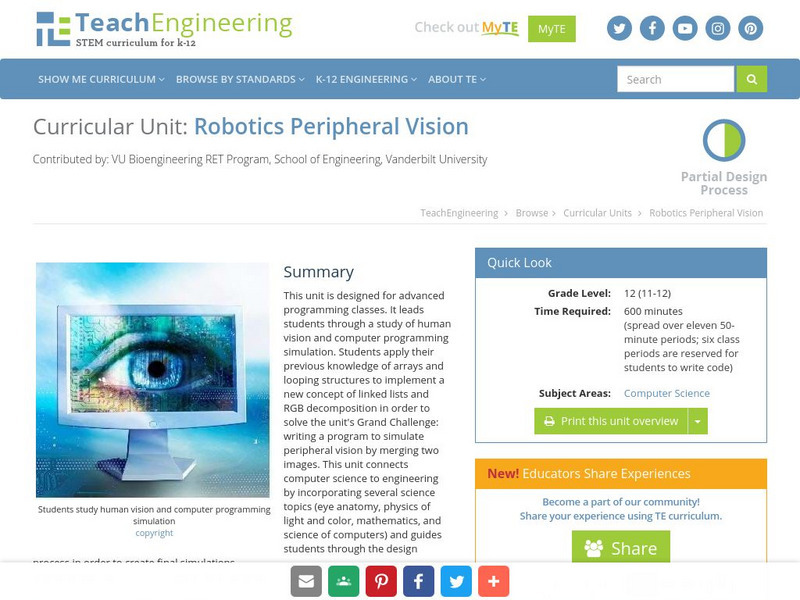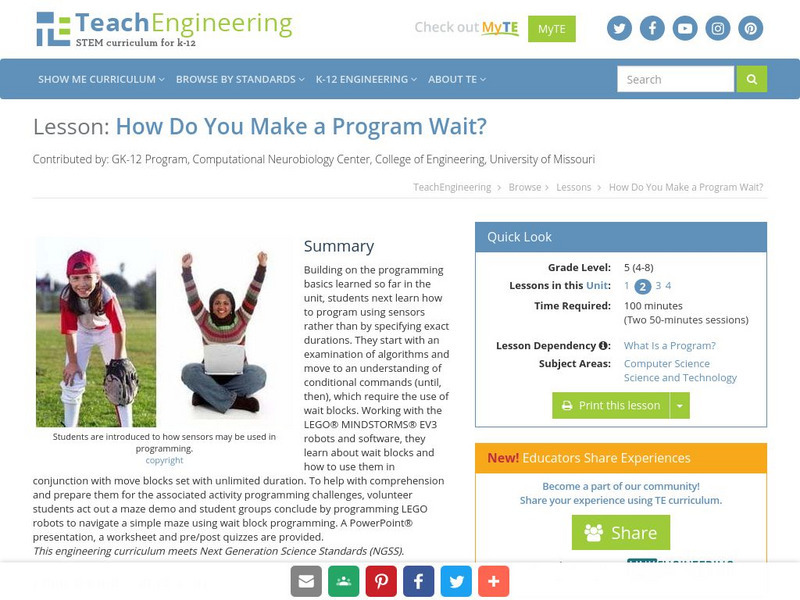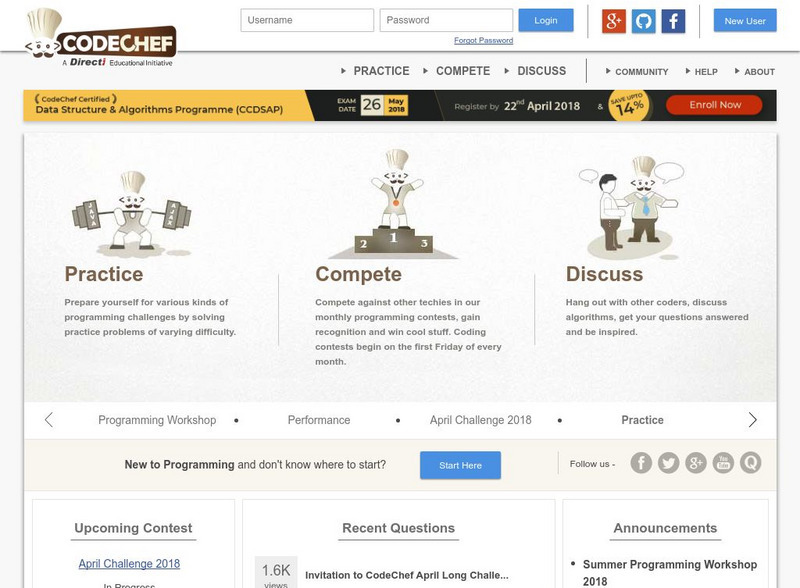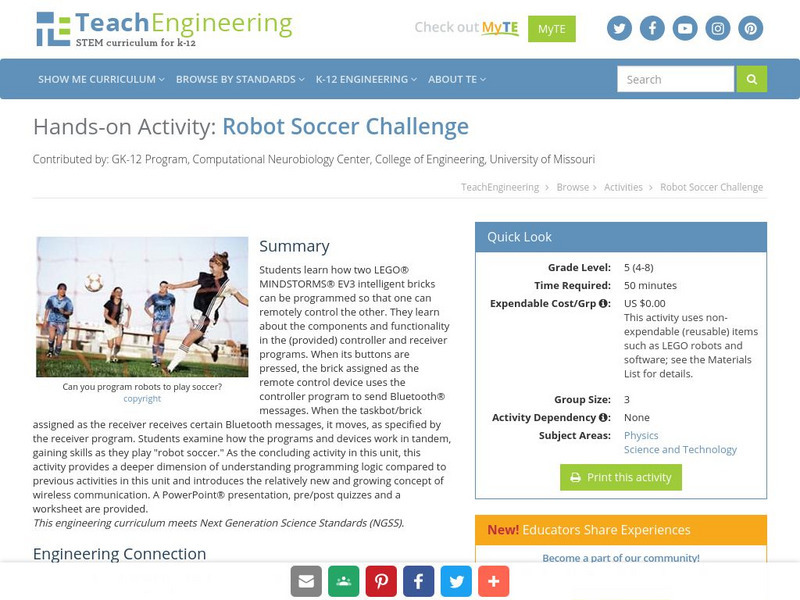TeachEngineering
Teach Engineering: Android App Development
Students develop an app for an Android device that utilizes its built-in internal sensors, specifically the accelerometer. The goal of this activity is to teach programming design and skills using MIT's App Inventor software (free to...
TeachEngineering
Teach Engineering: Mars Rover App Creation
Based on their experience exploring the Mars rover Curiosity and learning about what engineers must go through to develop a vehicle like Curiosity, students create Android apps that can control LEGO MINDSTORMS NXT robots, simulating the...
TeachEngineering
Teach Engineering: Python Script Analysis
Working in small groups, students complete and run functioning Python codes.This requires students to understand the logic employed, and then they must make modifications to the code in order to find the slopes of tangents to a variety...
TeachEngineering
Teach Engineering: What Is a Computer Program?
Through four lesson and four activities, students are introduced to the logic behind programming using LEGO MINDSTORMS NXT robots.
TeachEngineering
Teach Engineering: Android Acceleration Application
This unit includes two sequential lessons. In the first, students create mobile apps that collect data from an Android device's accelerometer and then store that data to a database. This lesson provides practice with MIT's App Inventor...
TeachEngineering
Teach Engineering: Robotics Peripheral Vision
This unit is designed for advanced programming classes. It leads students through a study of human vision and computer programming simulation. Students apply their previous knowledge of arrays and looping structures to implement a new...
TeachEngineering
Teach Engineering: What Is a Program?
Using a few blindfolds and a simple taped floor maze exercise, students come to understand that computers rely completely upon instructions given in programs and thus programs must be comprehensive and thorough. Then students learn to...
TeachEngineering
Teach Engineering: How Do You Make a Program Wait?
Building on the programming basics learned so far in a corresponding Robotics unit, students learn how to program using sensors rather than by specifying exact durations. Working with the LEGO MINDSTORMS NXT robots and software, they...
TeachEngineering
Teach Engineering: How Do You Make Loops and Switches?
Students learn how to program using loops and switches. Using the LEGO MINDSTORMS NXT robots, sensors and software, student pairs perform three mini programming activities using loops and switches individually, and then combined.
TeachEngineering
Teach Engineering: How Does a Touch Sensor Work?
Students look at human senses and their electronic imitators, with special focus on the skin and touch sensors. They have a chance to handle and get familiar with the LEGO touch sensor, including programming LEGO MINDSTORMS NXT robots to...
TeachEngineering
Teach Engineering: How Does a Sound Sensor Work?
Students learn about how sound sensors work, reinforcing their similarities to the human sense of hearing. This lesson and its associated activity enable students to appreciate how robots can take sensor input and use it to make...
TeachEngineering
Teach Engineering: Storing Android Accelerometer Data: App Design
Young scholars work through an online tutorial on MIT's App Inventor to learn how to create Android applications. Using those skills, they create their own applications and use them to collect data from an Android device accelerometer...
TeachEngineering
Teach Engineering: Android Acceleration
Students prepare for the associated activity in which they investigate acceleration by collecting acceleration vs. time data using the accelerometer of a sliding Android device. Based on the experimental set-up for the activity, students...
TeachEngineering
Teach Engineering: Python Calculus
Students analyze a cartoon of a Rube Goldberg machine and a Python programming language script to practice engineering analysis. This exercise enables students to see the parallels between a more traditional mechanical engineering design...
Other
Carnegie Mellon University: Alice
An innovative 3D programming environment that makes it easy for students to create an animation for telling a story, playing an interactive game, or a video to share on the web. This is a free teaching tool designed to be a student's...
Other
Sun Microsystems: The Set Interface
A description of the Set interface in the Java programming language.
Other
Directi: Code Chef
CodeChef provides a platform for computer programmers to practice their skills through posted problems where users can submit their solutions in the language of their choice. They can also interact with a community of fellow programmers...
Other
Ibm: Mastering Recursive Programming
A discussion of how to write a correct recursive algorithm. Numerous examples are given in several different programming languages.
TeachEngineering
Teach Engineering: Robot Soccer Challenge
Students learn how two LEGO MINDSTORMS NXT intelligent bricks can be programmed so that one can remotely control the other. They learn about the components and functionality in the controller and receiver programs
Code.org
Code.org: Cs Fundamentals: End of Course Project
This lesson plan provides students with space to create a project of their own design, using a step-by-step process that requires planning but also allows for broad creativity.
Google Cultural Institute
Google Cultural Institute: Women in Science, Technology, Engineering, and Math
Explore the historic reasons women are underrepresented in science, technology, engineering, and mathematics today.
National Women’s History Museum
National Women's History Museum: Getting With the Program
American women's contributions to the invention and formation of computer programing.
PBS
Pbs Learning Media: Let's Learn
This collection of resources for children ages 3-8 are drawn from the public television series Let's Learn, a partnership between the WNET Group and the New York City Department of Education. Let's Learn aims to provide our young...
PBS
Pbs Teachers: The Intimate Machine: Making Faces
Investigate the scientific innovation of giving computers facial features and expressions to improve human-computer interactions. Construct model faces that communicate six emotions using facial features including the mouth, eyes, and...

